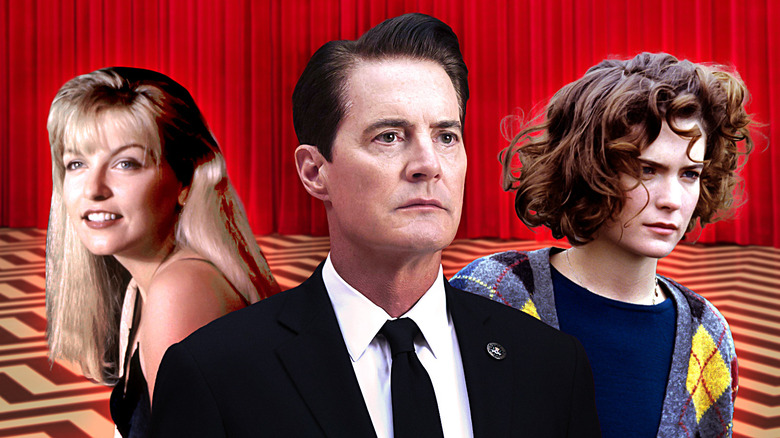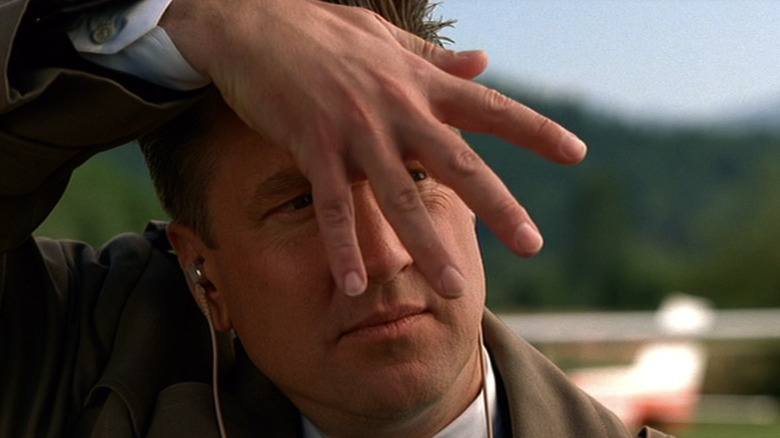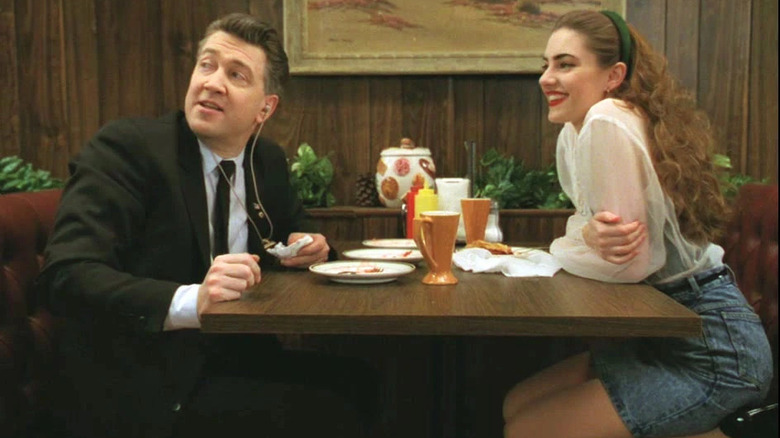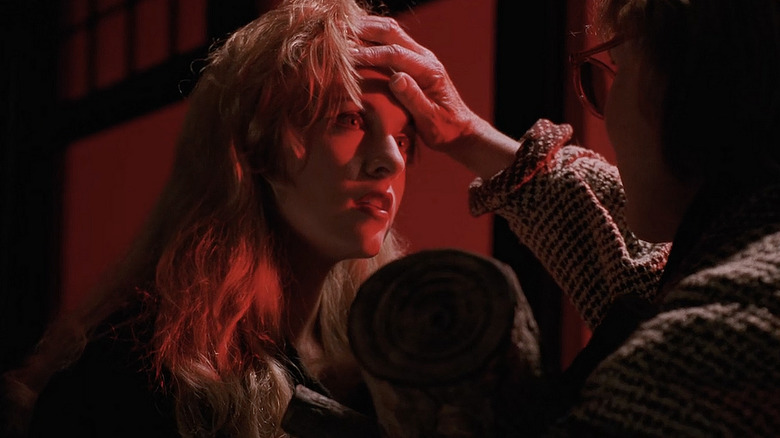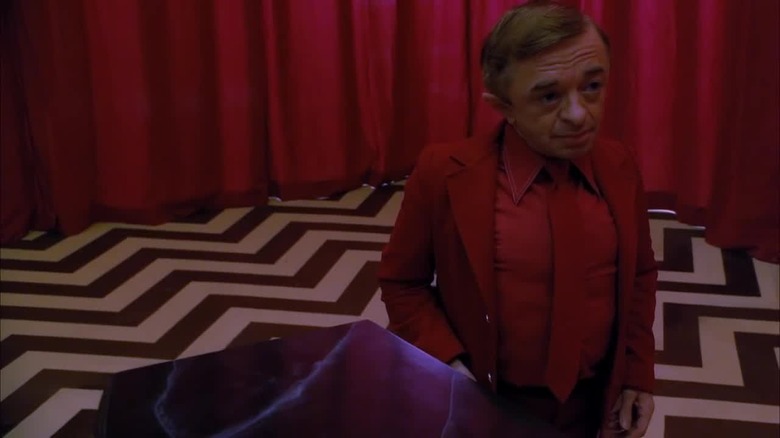The Correct Order To Watch David Lynch's Twin Peaks
Sometimes, the complex timeline of something like the "Fast and Furious" movies might mean the best order to watch the entries in a franchise may not be what you expect. Other times, a straightforward approach of watching entries in the order they were released makes the most sense. But for a nearly 30-year franchise like "Twin Peaks," which included two seasons of network TV, a movie, and a third TV season on a premium cable channel, trying to figure out the best way to approach it might leave you feeling like you've just taken a trip into the Red Room. We're here to help.
"Twin Peaks" experienced a massive boom in popularity when it debuted, followed by a decline in ratings that was nearly as sudden. After that first eight-episode hit season, ABC was hoping to turn it into the sort of mega multimedia franchise that "Star Wars" has become, but by halfway through the second season, the network executives realized they'd been way too hasty. The result is that the "Twin Peaks" viewing order is slightly more complicated than you'd think.
The correct order to watch Twin Peaks
To put it simply, the correct order to watch "Twin Peaks" looks like this:
- Season 1
- Season 2
- "Twin Peaks: Fire Walk With Me"
- "Twin Peaks: The Return"
Sounds easy, right? Well, there is also some bonus material to address, and some context you should probably know ahead of time.
One important thing to note here is that there are two versions of the pilot, and you should make sure you're watching the right one. If you're using an official streaming service, this won't be an issue, but if you're being a sleazy pirate, you might end up watching the international version by mistake. This is a version of the first episode with additional footage tossed in to turn it into a self-contained movie so the studio could still sell it even if the rest of the season wasn't greenlit. If you watch this version, the biggest question of the show — who killed Laura Palmer? – will be spoiled for you in that international pilot, so just watch the U.S. pilot instead.
Also, I've personally always considered everything from the pilot to "Episode 16" (season 2 episode 9) to basically be one big season, as "Episode 16" is when the big mystery of Laura's killer is finally resolved. It's wild to realize that the best part of the original "Twin Peaks" run, the episodes that many people saw and enjoyed, aired entirely within the span of eight months, from April 1990 to December 1990. After that, "Twin Peaks" mania fizzled out hard, but that doesn't mean it wasn't worth watching...
Why some people (wrongly) say you should skip the back half of season 2
Probably the biggest ongoing debate among the "Twin Peaks" fandom is over whether to keep watching the 22-episode season 2 after Laura's murder is solved. Fans often talk about season 2 as if there's two halves (before and after Laura's murder is resolved), but actually it was more like the season was split in thirds. The first third was the first nine episodes — let's call this season 2A. This section continued and resolved season 1's arc of figuring out Laura's murder, a creative decision forced on Lynch and co-creator Mark Frost by the studio heads at ABC.
The next seven episodes were produced with little involvement from either David Lynch or Mark Frost, which is part of why everyone hates this period. Lynch and Frost then convinced ABC to order six more episodes ("Episode 24" to "Episode 29"). These final six episodes were a return to form for the series, but they weren't enough to save the show's ratings. On June 10, 1991, "Twin Peaks" was over, seemingly for good.
I think new viewers should watch those final two thirds of season 2, even if means slogging through that middle segment. At the very least, you should try your best to enjoy "Episode 17" through "Episode 24." If you truly can't stand them, you can skip ahead to "Episode 24" to enjoy that golden final stretch of final season 2 episodes. But seriously, only do this if you've truly given the "bad" stretch a proper shot first.
Some advice on Twin Peaks: Fire Walk With Me
This is a prequel film, leading some prospective viewers to wonder if that means they should watch it first. Definitely don't! "Twin Peaks: Fire Walk With Me" spoils the big whodunnit mystery that makes up so much of the show's early series. Not only that, but it's best enjoyed in the context of all the weirdness that came before it. "Fire Walk With Me" is very much on the same level of strangeness as season 2 of "Twin Peaks," not the comparatively more straightforward season 1, except the strangeness works better here because Lynch no longer has ABC meddling in his creative process.
It's best to treat this movie as the bridge between the original show and the 2017 revival, even if that wasn't Lynch's original plan. (He always loved "Fire Walk With Me" and was hoping it could be the start of a film trilogy, but its terrible box office performance dashed those dreams quickly.)
Another option: Because "Fire Walk With Me" largely focuses on Laura Palmer's final days, it doesn't actually spoil anything beyond season 2A. So, if you're struggling through that rough patch in season 2A and want to give yourself a treat, you can put this (amazing) movie on and it won't harm your experience of season 2B or 2C in any way.
Bonus material to check out
During that brief period in the aftermath of season 1, ABC had ambitious plans to turn "Twin Peaks" into a massive long-running multimedia franchise. The result was we got a couple of fun books about the series that are technically canonical, such as "The Secret Diary of Laura Palmer," written by David Lynch's daughter, Jennifer. It's a fictional diary told from Laura's perspective that includes a lot of insights into the character's childhood. There's also "Welcome to Twin Peaks: An Access Guide to the Town," published in 1991, and "The Secret History of Twin Peaks," which came out in 2016. Film-wise, there's also "The Missing Pieces," a collection of deleted scenes from "Fire Walk With Me" that are definitely worth the watch.
Do you have to watch/read any of this? No, but if you want to get into the head of a "Twin Peaks" fan who was there from the beginning, who had almost no new material to work with from those cold hard years of 1992 to 2017, this is a great way to do it.
I'd also suggest giving some of David Lynch's other films a try, if you haven't already. While the original run of "Twin Peaks" had the most in common with Lynch's 1986 film "Blue Velvet," the revival was more in line with later Lynch films like "Lost Highway" (1997), "Mulholland Drive" (2001), and "Inland Empire" (2006). You should definitely give at least one of these films a watch, as "Twin Peaks: The Return" (which was released on Showtime in 2017) gets far more Lynchian than the original series ever did.
